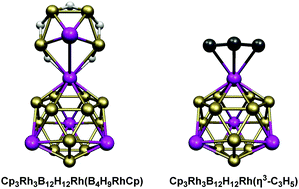The tetracapped truncated tetrahedron in 16-vertex tetrametallaborane structures: spherical aromaticity with an isocloso rather than a closo skeletal electron count†
Abstract
Density functional theory studies on the experimentally known Cp*3Rh3B12H12Rh(B4H9RhCp*) as well as the model compounds Cp4Rh4B12H12 and Cp3Rh3B12H12Rh(η3-C3H5) indicate low energy structures with central Rh4B12 tetracapped tetratruncated tetrahedra (TTT) for these 32 Wadean skeletal electron systems. This skeletal electron count corresponds to 2k2 (k = 4) skeletal electrons suggesting a spherical aromatic system with filled 1s + 1p + 1d + 1f molecular orbitals as well as an isocloso 2n (= 32 for n = 16) skeletal electron count. Similar TTT structures are found for the valence isoelectronic 32 skeletal electron systems [Cp4M′′4B12H12]4+ (M′′ = Ni, Pd, Pt) and [Cp4M′4B12H12]4− (M′ = Fe, Ru, Os). The preferred structures of the 34 skeletal electron systems [Cp4M4B12H12]2− (M = Co, Rh, Ir), [Cp4M′′4B12H12]2+ (M′′ = Ni, Pd, Pt) are not the most spherical TTT despite their 2n + 2 skeletal electron count (= 34 for n = 16) for a closo structure by the Wade–Mingos rules. Instead they are prolate (elongated) polyhedra with two degree 6 and two degree 5 metal vertices with a central M4 macrobutterfly having one long M⋯M distance of ∼5.0 Å between the wingtips. The preferred structures for the still electron richer 36 skeletal electron systems Cp4M′′4B12H12 (M′′ = Pd, Pt) are derived from triple square antiprisms with two open M′′2B2 square faces. A distorted version of this polyhedron is the deltahedral structure with four degree 5 metal vertices and four degree 6 boron vertices found in the valence isoelectronic 36 skeletal electron first row transition metal derivatives Cp4Ni4B12H12 and [Cp4Co4B12H12]4−. However, this polyhedron is not found in the 36 skeletal electron [Cp4M4B12H12]4− (M = Rh, Ir), that instead have symmetrical central M4B12 TTTs. For some 16-vertex [Cp4M4B12H12]z systems deviating from the favored 32 skeletal electron count, low-energy structures are found in which hydrogen atoms migrate to bridge B–B edges or bend over to bridge M–B edges. In addition, the hypoelectronic hexacations [Cp4M4B12H12]6+ (M = Co, Rh, Ir; Ni, Pd, Pt) are found to have low-energy structures in which three of the four Cp rings are hydrogenated to give tetrahapto cyclopentadiene η4-C5H6 rings.



 Please wait while we load your content...
Please wait while we load your content...